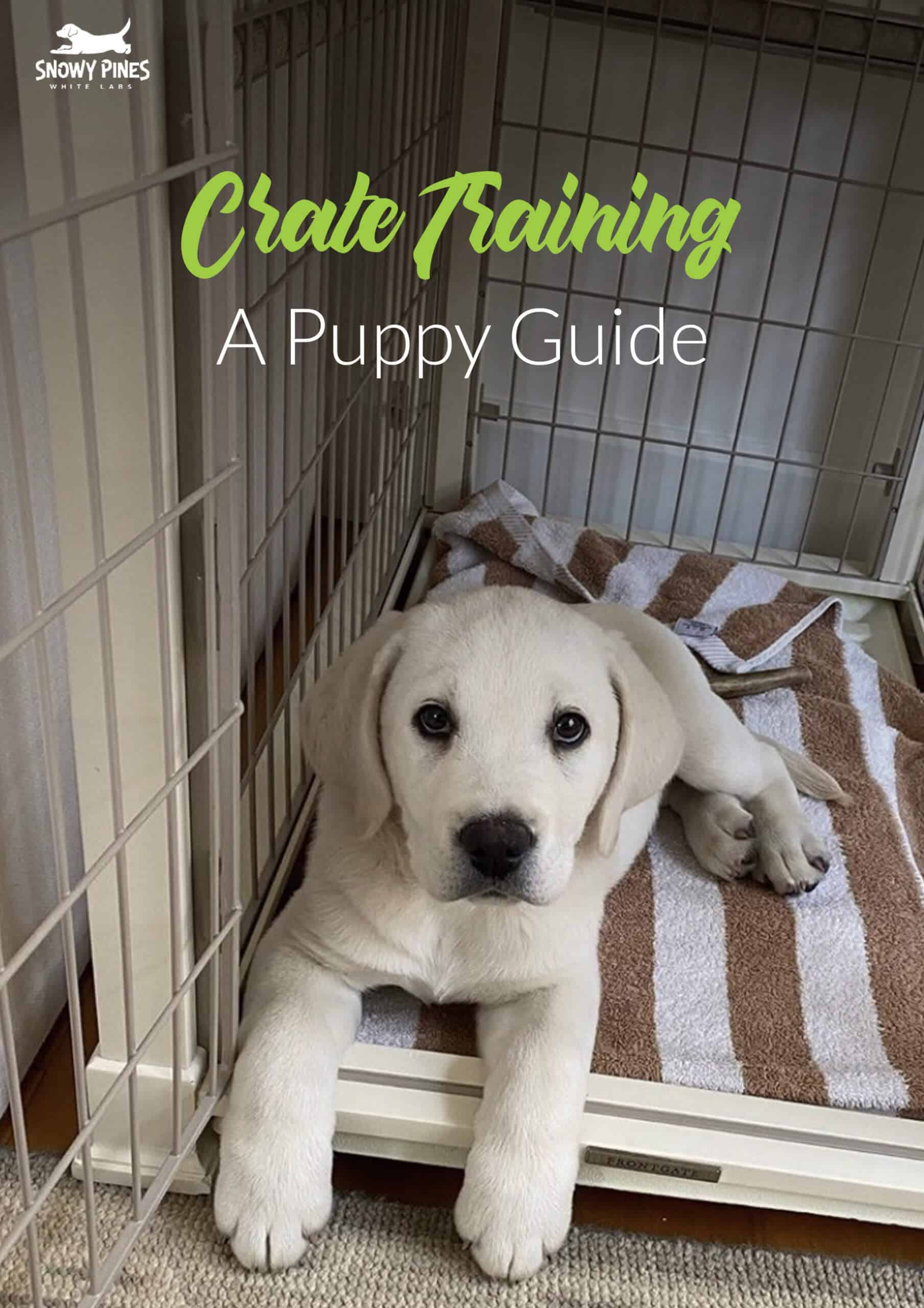
Crate training is the process of teaching your puppy to accept a crate as a familiar and safe place. The practice relies on your puppy’s instincts of “denning,” which refers to a dog’s natural willingness to seek a private and secure place when their environment becomes stressful.
Crate training is not a way to confine your puppy if he misbehaves. It should be used as a helpful tool for both puppy and you. In fact, crate training reaps numerous benefits, such as easier potty-training, offering your puppy a safe space, experiencing less stress, and giving you peace of mind when you’re out of the house.
Benefit #1
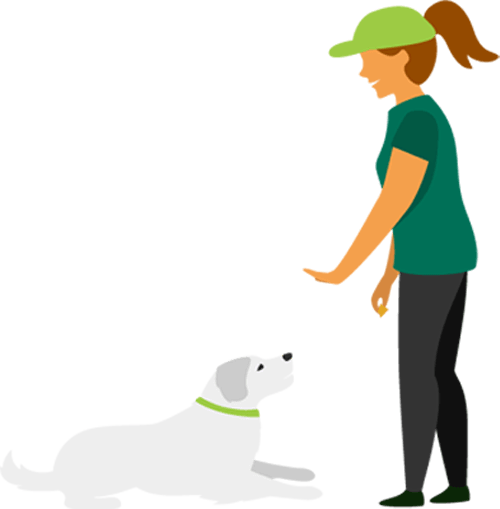
“When they’re puppies, the crate really is the major tool that will help you house train,” says trainer Heike Purdon. “It teaches them that freedom is a privilege and you get more space as your house training skills become better”
By enforcing crate training techniques, you’re teaching your puppy your household’s routine and that it’s one that they must adhere to. When you have a schedule that tells him when it’s crate time or outdoor time, your puppy will learn when and where to potty.
Plus, puppies will usually do their best to avoid soiling in their crates. They will learn that their crate is their space, and therefore don’t want to make it dirty. In this way, training your puppy to accept the crate as their personal domain can help prevent accidents at night or when they’re left alone.
If your puppy is constantly soiling their crate, they may need more frequent potty breaks. Remember that puppies under four months old should not be left in their crate for more than four to 6 hours hours at a time (unless trained to do so), which means that they need a midnight potty break when you’re sleeping and a pet sitter to let them out if you’re at work. Learn more in the Commonly Asked Questions section about frequent crate accidents.
Benefit #2
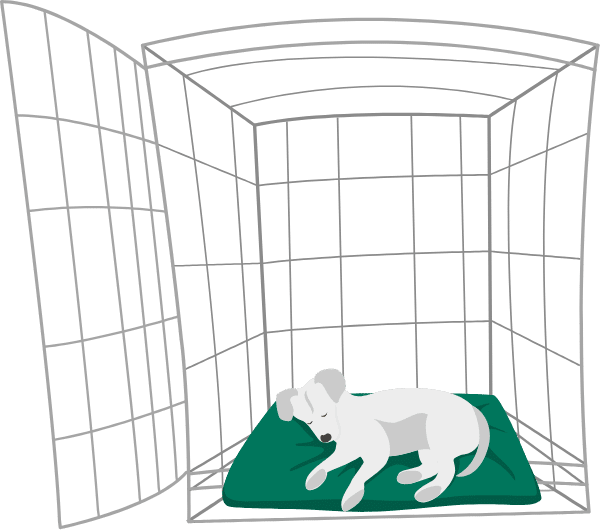
“Giving pups a calm, cozy place to call their own can help them feel safer and more secure,” says Katy Nelson, DVM, the senior veterinarian for Chewy. “A warm bed, some white noise, a toy to chew on… can help to ease anxiety and create a space they seek out when they need a haven.”
Like humans, puppies and dogs need a safe place to go when they’re tired, overwhelmed, and stressed. Crates are ideal for when strangers are in the home, parties are going on, or there is too much noise. Instead of holding up your pup in the kitchen or spare bedroom, his crate becomes the designated safe space.
Additionally, crating your puppy while traveling may allow for less stress. Successfully crate training your puppy for necessary trips (like going to the vet) can offer a sense of familiarity, even when he’s feeling uncomfortable.
Benefit #3
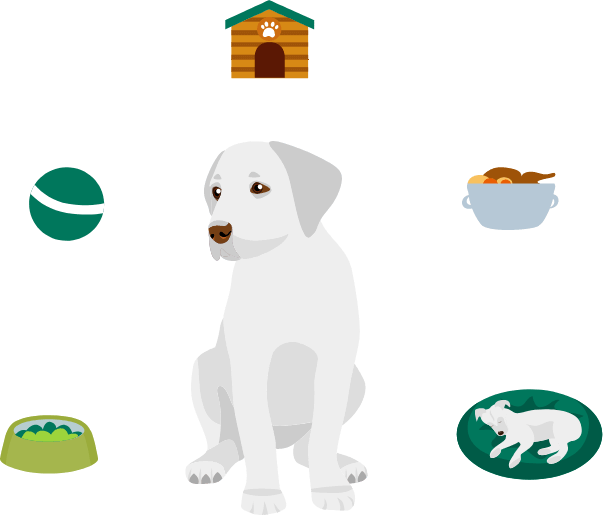
Routine is crucial for all dogs—but it’s especially helpful for puppies who rely on their schedule to know what’s next, especially when it comes to potty training, eating, and sleeping.
“Dogs thrive on a routine, in large part because they don’t have to worry about what is—or is not about to happen next,” says veterinarian Jennifer Coates. “A dog who is feeling a degree of urgency is much more likely to hold it if he knows that he’s going to have an opportunity to relieve himself soon.”
Getting your puppy used to the new routine will make for an easier transition when it comes to your daily schedule. When you stick to a schedule that involves crating, he will begin to understand what to expect next. Crate also while they are home (for short periods), so that way they do not associate the kennel with you leaving, which in turn can lead to separation anxiety/destructive behaviors/more accidents.
Benefit #4
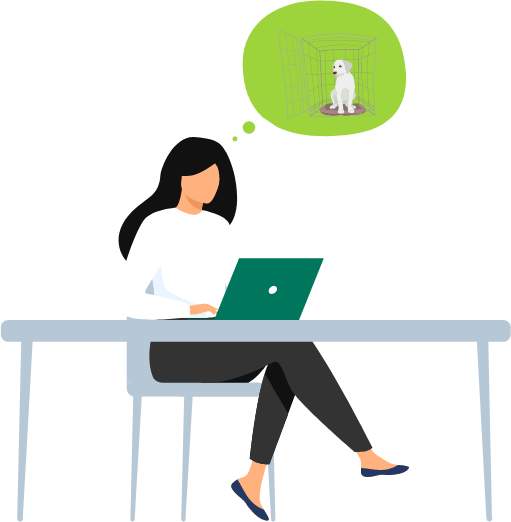
When you have a new puppy in the house, a million things can go wrong when you’re not watching. Since they require plenty of stimulation, puppies tend to chew on everything.
So if your puppy is left to wander the home all by himself, then chances are he’ll chew on the furniture, get into the garbage, or even soil the floor. But when you use a crate, you know that your home isn’t getting destroyed while you’re gone. This offers peace of mind when you’re away.
Crates should be a tool in your training, so there are things that you should know to avoid before you get started:
There are three types of crates you can select from when shopping for your puppy:
No matter which type you choose for your puppy, size is the most crucial factor. The crate should be large enough for your pup to stand up and turn around. For example, chihuahuas can do well in small crates, while larger dogs like labradors require XX-large crates.
Some breeds continue growing for up to two years, so you’ll want to invest in a crate that will accommodate their adult size from when they’re a puppy. If you’re unsure of how big your dog will get, then try doing some research based on his breed’s genetics. You could also rent crates and change them out for every stage of your pup’s life.
When crate training your puppy, the key is to be consistent and positive, which means that you might find yourself repeating some of these steps a few times. Remember that your pup doesn’t understand English, so it’s going to take some time for your puppy to catch on. Using this step-by-step guide will help get you and your puppy off to a great start.

Step #1
Introducing your puppy to a new crate shouldn’t be a formal process. In fact, you should set up the crate in a common area where the whole family hangs out. Add a blanket or bed inside and allow your pup to check it out at his leisure without any coaxing.
Sometimes, dogs will automatically go in and lay in their crate. If this is the case, immediately give your puppy a treat (especially if it’s a special treat that will stimulate his attention, like a peanut butter-filled toy).
Others, however, require a little extra patience. Here are some ways that you can get your pup more comfortable in the presence of the crate:

Step #2
After your puppy becomes familiar with the crate and is comfortable in its presence, it’s time to begin feeding meals in the crate. The goal is to get your puppy to positively associate the crate with things he likes best (like food!).
If your puppy is nervous about going inside all the way, only place the food bowl as far as they’ll go. For some, this may mean eating right at the entrance. For other puppies, they may choose to go halfway in and halfway out. It may take a few days (or weeks) until he fully walks inside to eat.
When your puppy begins eating his meals completely inside the crate, gently close the door behind him. During the first few attempts, open the door immediately after he’s finished eating. After that, you can gradually leave the door closed a little longer for up to 10 minutes at a time.

Step #3
Once your puppy is comfortable being inside his crate for a few minutes, it’s time to practice longer crating periods. Remember that your dog should see his crate as a positive place, so it’s smart to add toys and treats.
A great example is a KONG toy filled with peanut butter. If you toss this into your puppy’s crate, he can spend quite some time gnawing down on the peanut butter. He’ll be so preoccupied with such a fun treat that chances are he won’t even mind he’s in a crate.
This method helps your puppy get used to being crated for a long time while also associating it with a
positive activity.
When it’s time to put your puppy in his crate, follow this step-by-step guide:
Keep practicing this until your puppy can sit in the crate for up to 30 minutes without issue. When he can sit quietly for that long, you can move onto the next step where you’ll practice crating him while you’re away.
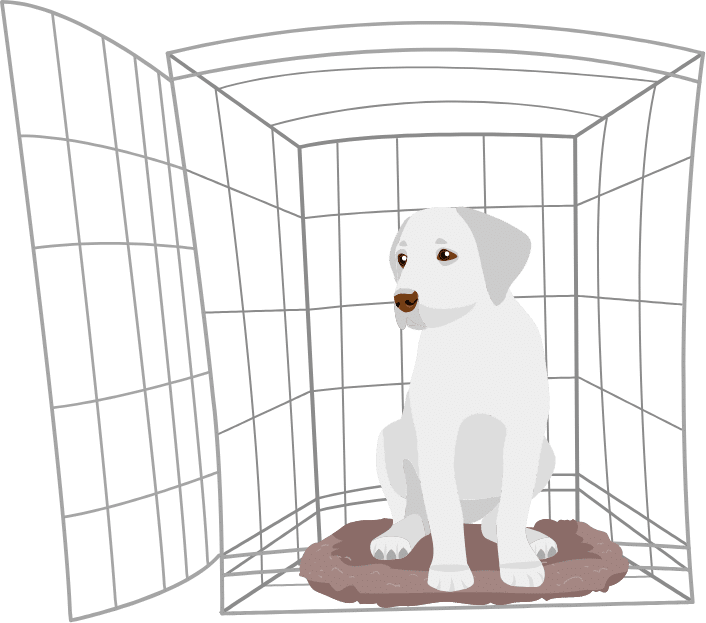
Step #4
The ultimate test is seeing how your puppy does in his crate when you’re away for a couple of hours at a time. As you begin to leave, here’s what you should do:
After your puppy has gotten better about being crated for more extended periods, you can practice crating him at night. Depending on his age, you may still be potty training. This means you’ll still have to let him out for a potty break. Around four months of age, puppies are usually able to sleep through
the night
When it’s bedtime, here’s what you should do
Also, be calm when putting your puppy in the kennel and getting them out. If you make a big deal of you leaving and putting them in the crate it can also heighten their anxiety about you leaving and coming home. You want them to be calm going in and coming out.
Simply knowing the steps to successful crate training doesn’t mean that you’re left without unanswered questions. Crate training is a crucial part of your puppy’s early life, and basic training can affect the way his temperament develops as he matures. Here, you can find helpful answers and sources to your burning questions about crate training.
You can put your puppy in his crate overnight. Begin by placing his crate near your bed; this doesn’t have to be a permanent location, but your puppy finds comfort in your presence, so being near you will make for an easier transition.
“Your puppy will fall asleep when you fall asleep because he’s right there next to you,” says dog trainer Dr. Carolyn Lincoln. “He can smell you. If he starts crying you can put your hand next to him.”
While you can crate your puppy overnight, keep in mind that you’ll still need to take it on midnight potty breaks if he’s still under four months old. Most experts agree that by the time your puppy is around that age, he should be able to hold his bladder through the night. Professional training can help reduce this age.
The key to a successful full-night’s sleep is to establish a routine, like feeding and giving water several hours before bed so that he doesn’t fall asleep on a full bladder.
There are many reasons your puppy may be continuously soiling in his crate. The first step is figuring out why: Does he need more potty breaks? Is the crate too big? Is he feeling anxious?
If he needs more potty breaks, then it’s time to adjust your puppy’s pottying schedule. Try to keep note of how often he soils his crate and the time between accidents. If he has accidents at night in his crate, then you should take him out for a potty break earlier than your current schedule allows.
Another reason may be that the crate is too big. Let’s say you have a labrador puppy, so you bought an XXL-crate to accommodate its adult size. But when your XXL-dog is still a small puppy, there’s a lot of extra, unused space.
Sometimes, puppies will see this unused space as an area to poop and pee because it’s far enough away from their sleeping spot. That’s why many owners end up closing off half of the crate until the puppy’s grown a bit more.
Separation anxiety is a significant contender to consistent soiling in the crate. It’s crucial that you begin recognizing the signs of anxiety and know how to address them.
Separation anxiety is when your puppy is showing extreme stress from being alone. This usually begins when you leave and ends when you return. Unfortunately, puppies can experience separation anxiety even if they’re in their crate and the same room as you.
Here are common symptoms of separation anxiety while crate training:
Unfortunately, dealing with separation anxiety is not easy. In fact, it’s one of the leading reasons that owners get rid of their dogs. So, what do you do if your puppy is experiencing this type of stress?
The key to treating separation anxiety in puppies is “to resolve the dog’s underlying anxiety by teaching him to enjoy, or at least tolerate, being left alone,” says the Tufts School of Veterinary Medicine. You can do so through several changes in your schedule, like:
Furthermore, crate training can help with separation anxiety. If your pup is experiencing this anxiety and stress while being crated, this may mean that you’re trying the crate training process too quickly, and it’s time to slow down the training or to move a step backward.
“The number one mistake people make with crate training is moving too fast,” says dog behavior specialist Scott Sheaffer.
Take a look at the step-by-step guide above and identify where exactly your puppy is having issues. Take time to focus on the prior step or move more slowly on the current one. You may also reach out to us for help in training your puppy via our Virtual Puppy Training University.
You certainly can hire someone to crate train your puppy! In fact, studies have shown that enrolling in puppy classes can have numerous benefits like natural friendliness toward strangers and better listening when it comes to commands. Programs like the ones at Snowy Pines White Labs offer crate training as well as other important lifestyle and behavioral training, like socialization, travel readiness, basic commands, and leash training. With the option to advance to other types of training basics and techniques, these basic skills are crucial for any puppy to get the hang of.
Crate training your puppy offers a plethora of benefits, like house training, acting as a safe space, enhancing routine, and giving you peace of mind. If you’re ready to begin crate training your puppy, then be sure to take these steps:
If you’re adopting soon and need some extra help with crate training your new puppy, then Snowy Pines White Labs has got your back with in-person puppy training classes and other extensive online guides. Utilizing these resources will help make for an easier transition for you and your puppy—guaranteeing years of happiness to come.